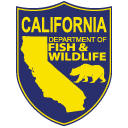 Striped seaperch are found statewide, but are rarely seen south of Point Conception. They are found to depths of around 55 ft., although they prefer shallow water less than 18 ft. deep. Striped seaperch are often found in rocky areas with dense algal growth including kelp beds, which harbor abundant prey.
Striped seaperch are found statewide, but are rarely seen south of Point Conception. They are found to depths of around 55 ft., although they prefer shallow water less than 18 ft. deep. Striped seaperch are often found in rocky areas with dense algal growth including kelp beds, which harbor abundant prey.
Distinguishing Characteristics
- Coppery, darker brown dorsally.
- About 15 horizontal, neon blue stripes on the body below the lateral line.
- Several series of blue spots and stripes on head.
- Fins coppery.
Life History & Other Notes
Striped seaperch have a relatively large mouth which lends itself to a diverse diet, including shrimps, crabs and other crustaceans, marine worms, mollusks, and sometimes brittle stars. They feed throughout the day, selecting prey visually and eating relatively large, heavy prey when it is available.
Young striped seaperch are born in the summer months during times of dense kelp growth, and use the kelp understory as cover along with pile perch, rubberlip seaperch, and other young fish. Although juvenile striped seaperch and black perch sometimes school together, adults of these species compete for food. Wherever the two species inhabit the same general area, striped seaperch will aggressively eliminate black perch from its immediate home range to a depth to 18 ft.
Striped seaperch are an extremely popular sport fish. They may comprise up to 10 percent of all fishes caught in the recreational fishery (excluding salmon) north of San Francisco.
Striped Seaperch Quick Facts:
Scientific Name: Embiotoca lateralis
Other Common Names: striped surfperch, blue perch
Range & Habitat: Statewide, but most common north of Point Conception in rocky areas with dense algae growth
Length & Weight: To 15 in. and 2+ lb.
Life Span: To 10 years
Diet & Suggested Bait: Eats shrimp, crabs and other crustaceans, marine worms, and mollusks. Use light line and small hooks with a variety of baits.
Excerpt from the California Finfish and Shellfish Identification Book.
Single copies of the book are available to California residents free of charge by emailing a request to publications@wildlife.ca.gov.

